My Blue Latex Dress
|
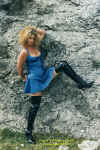
|
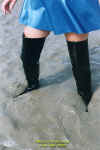
|
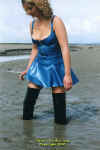
|
I had
plenty of requests to see a before shot. I
Hope this will surfice.
|
Also, many of you asked to
see a more detailed slow sink. So here we go. Best foot
forward. |
Inch by inch, down we go,
where we stop nobody knows. |
|

|

|

|
| I hope this is slow and progressive
enough for you. |
Just past the knees now. It's going well
and I'm feeling good. |
Hit a hard bit here. Push down hard on right leg. |
|

|
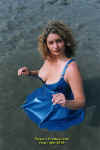
|

|
| One thing about this latex dress, It's
easy to clean. Arms out to keep my balance. |
O K. so I bet you are wondering what I am
wearing under this dress. Am I correct ? |
Well, now you know. A little black
G string, but don't tell every one. |
|

|

|
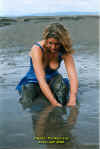
|
| Time to try and get out. Arghhh, you
would not believe the suction. |
Nearly out. Always feel safer when I get to
this stage. Time for a smile. |
The legs are getting tired. Dig down, find my
foot and pull................. |
|

So whilst your sat there,
with all your creature comforts around you, spare a
thought for me. I do enjoy doing this but it isn't easy. |
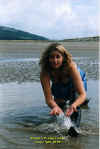
|
Quite a few of you asked to see me cleaning off using
a hose pipe. Unfortunately we are 2 miles from the
nearest house. It would be one hell of a long pipe to
reach here. So I just make do with what's available.
|
A few words about sinking
in this type of material.
After reading the e-mails I have received, I
am under the impression that there are some of you who may be
unaware and unfamiliar with the type of material you can see me
in here. This material is not a liquid. I cannot simply walk
along the beach and then suddenly start sinking in a soup like
mire. For most part it is a solid, or at the very least a
semi-solid. I can walk on it and indeed in most cases might not
even be aware that I am walking on quicksand, but like anywhere,
some areas are less stable than others. When I reach a spot that
feels suitable to sink into, it feels like I am standing on the
top of a giant jelly. The surface can dip down for upwards of 10
feet in diameter, to about 10 to 12 inches from the normal level.
Often it is possible to jump up and down on this area much like a
trampoline ! and if I don't break the surface I won't sink. But
when I start to shake my legs, I then begin to liquefy the sand
and I start to sink. Stop shaking and I stop sinking. But this is
where the danger aspect raises it's ugly head. Whilst I am
shaking and liquefying the area, I am dispersing the water in the
sand. ( take a look at the second photo, solid / semi solid, no water on
surface. now look closely at subsequent photo's. See how much water is on the
surface as I work my way in and out. )Some areas contain more water than others. If I pick a bad
spot and sink even to my knees if all the water disperses the
sand can turn into concrete in seconds. You could then go and get
a tractor and rope to pull me out , but before I have moved 1
inch all you would achieve is to pull my legs out of their
sockets ( NO THANK YOU). Start digging and the sand flows back
in. What do you do? You dig, shake and GENTLY pull. Slowly I come
up, out and free. Even at knee deep this can take upwards of half
a hour even with the my two photographers, Mirador and Slippy
helping. Phew, it's hard work but I love it...
I have complete trust in the people who I work with, they have an
extensive knowledge of the area and the material...I'm lucky.
MUDFLATS ARE DANGEROUS
PLACES...PLEASE UNDER NO CIRCUMSTANCES WANDER OUT ONTO THEM
WITHOUT FIRST SEEKING ADVICE REGARDING TIDES AND LOCAL
CONDITIONS, AND UNDER NO CIRCUMSTANCES SHOULD YOU VENTURE OUT
ONTO THEM ALONE.
If you are at all interested in
getting more information regarding this material then I would
like to direct you to my good friend Mirador's site, Mired.
He has a bit more experience of this material than I do













